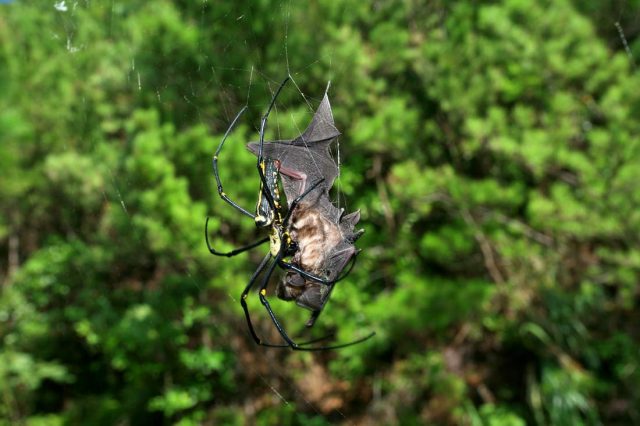MI weekly selection #15

Bat-eating spiders are more common than you think
Bat-eating spiders are more common in the world than once believed. These spiders are found on all continents except Antarctica. Almost 90% of the web-building spider and tarantula species live in warmer climates, and can capture bats both with and without a web.
Nyffeler M, Knörnschild M (2013) Bat Predation by Spiders. PLoS ONE 8(3): e58120. DOI:10.1371/journal.pone.0058120
Earthquakes have the Midas touch
Water in the Earth’s faults is rich in carbon dioxide, silica and elements such as gold, which gets left behind when the water evaporates during an earthquake. A research found that the amount of gold left behind from one earthquake is minute, but an active fault line — like New Zealand’s Alpine Fault — is capable of building a sizable mineral deposit in just 100,000 years.
Dion K. Weatherley & Richard W. Henley (2013) Flash vaporization during earthquakes evidenced by gold deposits Nature Geoscience DOI: 10.1038/ngeo1759
100,000-year-old skull shows signs of inbreeding
Analysis of a 100,000-year-old human skull discovered in China found evidence of in-breeding, a practice that may have been quite common among early humans. The Xujiayao 11, named after the site where it was found, had signs of congenital abnormalities, and likely comes from a small, isolated population of early humans. Skulls from the Pleistocene epoch, about 2.6 million to 12,000 years ago, often display signs of genetic abnormalities, reinforcing the idea that “during much of this period of human evolution, human populations were very small” and likely inbred, said the study’s lead researcher Erik Trinkhaus.
Wu X-J, Xing S, Trinkaus E (2013) An Enlarged Parietal Foramen in the Late Archaic Xujiayao 11 Neurocranium from Northern China, and Rare Anomalies among PleistoceneHomo. PLoS ONE 8(3): e59587. DOI:10.1371/journal.pone.0059587
Link between hypertension and Alzheimer’s disease
Researchers used MRI and PET to measure levels of amyloid plaque, which is considered a risk factor for the disease. Patients with a genetic predisposition to Alzheimer’s who were taking medication for hypertension had plaque levels that were no greater than other study subjects.
Karen M. Rodrigue, Jennifer R. Rieck, Kristen M. Kennedy, Michael D. Devous, Ramon Diaz-Arrastia, Denise C. Park (2013) Risk Factors for β-Amyloid Deposition in Healthy Aging JAMA Neurol. DOI: 10.1001/jamaneurol.2013.1342.
Bacteria can self-destruct for the good of the colony
Bacterial organisms may self-destruct as a means to prevent the spread of viruses that could kill an entire colony. The study examined two strains of Escherichia coli bacteria and found that bacterium infected with a virus would kill itself before the virus had a chance to spread. Self-destruction ultimately has little effect on the rest of the colony, researchers say, meaning that a suicidal bacteria colony has a higher chance of survival than non-suicidal bacteria, which succumbs quicker to viruses.
Dominik Refardt, Tobias Bergmiller and Rolf Kümmerli (2013) Altruism can evolve when relatedness is low: evidence from bacteria committing suicide upon phage infection Proceedings of the Royal Society B DOI: 10.1098/rspb.2012.3035